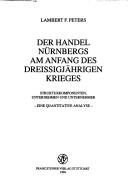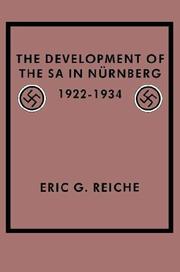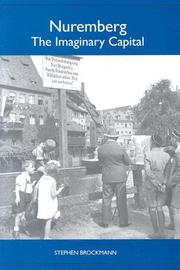| Listing 1 - 8 of 8 |
Sort by
|

ISBN: 3515062882 Year: 1994 Volume: 112 Publisher: Stuttgart : Franz Steiner,
Abstract | Keywords | Export | Availability | Bookmark
 Loading...
Loading...Choose an application
- Reference Manager
- EndNote
- RefWorks (Direct export to RefWorks)
Nuremberg (Germany) --- Nuremberg (Allemagne) --- Commerce --- History --- Histoire --- -Commerce --- -History --- Nürnberg (Germany) --- Norimberga (Germany) --- Nyremvergē (Germany) --- Ni︠u︡rnberg (Germany) --- History. --- Nuremberg (allemagne) --- 17e siecle
Book
ISBN: 3412518697 Year: 2019 Publisher: Wien : Böhlau Verlag,
Abstract | Keywords | Export | Availability | Bookmark
 Loading...
Loading...Choose an application
- Reference Manager
- EndNote
- RefWorks (Direct export to RefWorks)
Heute bestimmen die Nürnberger Hauptpfarrkichen St. Sebald und St. Lorenz das Bild vom Glanz der Reichsstadt am Ende des Mittelalters. Der vorliegende Band richtet den Fokus zusätzlich auf weniger Bekanntes aus Architektur und Bildender Kunst des 14.-16. Jahrhunderts. Nürnberg zählt noch immer zu den Städten mit dem reichsten und künstlerisch bedeutendsten Erbe aus Spätmittelalter und Früher Neuzeit aufgrund seiner wirtschaftlichen Bedeutung, geprägt durch Handel, Handwerk und frühe manufakturielle Fertigung. Dies war der Boden für die Blüte der Künste. Der reich bebilderte Sammelband gibt mannigfache Anstösse, sich mit diesem Kulturerbe eingehender zu beschäftigen. Schwerpunkte bilden die ehemalige Deutschordenskirche St. Jakob und insbesondere ihr bedeutendes Hochaltarretabel des 14. Jahrhunderts sowie die Untersuchung medialer Aspekte von Werken der Dürerzeit.
Church architecture --- Nuremberg (Germany) --- Germany --- Buildings, structures, etc. --- Nürnberg (Germany) --- Norimberga (Germany) --- Nyremvergē (Germany) --- Ni︠u︡rnberg (Germany) --- Neurenberg (Germany)

ISBN: 0511529007 0521306388 0521524318 Year: 1986 Publisher: Cambridge : Cambridge University Press,
Abstract | Keywords | Export | Availability | Bookmark
 Loading...
Loading...Choose an application
- Reference Manager
- EndNote
- RefWorks (Direct export to RefWorks)
In Nürnberg, as in other German cities, the SA (or stormtroopers) was the most visible Nazi organisation prior to the seizure of power by Hitler in 1933. This book looks in close detail at the development of the SA from its inception in 1922 until its overthrow by Hitler in 1934. More than a history of marches and violent encounters, the book analyses why, in a heavily industrialized city where the forces of democracy initially enjoyed strong support, a growing number of men from virtually every group of society decided to become members of the SA. Drawing from the biographical data of more than 350 stormtroopers and from extensive research in German archives, Professor Reiche reveals both the significance of the First World War and peer pressure, as well as the impact of the Great Depression, on the growth of the SA.
Nationalsozialistische Deutsche Arbeiter-Partei. --- S.A. (Sturmabteilung) --- SA (Sturmabteilung) --- Stormtroopers --- Nationalsozialistische Deutsche Arbeiter-Partei --- History. --- Nuremberg (Germany) --- Nürnberg (Germany) --- Norimberga (Germany) --- Nyremvergē (Germany) --- Ni︠u︡rnberg (Germany) --- Politics and government. --- Arts and Humanities --- History --- Brownshirts (Sturmabteilung) --- Neurenberg (Germany)

ISBN: 1281949523 9786611949525 1571136827 1571133453 Year: 2006 Publisher: Rochester, New York : Camden House,
Abstract | Keywords | Export | Availability | Bookmark
 Loading...
Loading...Choose an application
- Reference Manager
- EndNote
- RefWorks (Direct export to RefWorks)
Traces the development of ideas of Nuremberg as cultural and spiritual capital, thus offering a coherent view of German cultural and intellectual history. Nuremberg: The Imaginary Capital is a broad study of German cultural history since 1500, with particular emphasis on the period since 1800. It explores the ways in which Germans have imagined Nuremberg as a cultural and spiritual capital, focusing feelings of national identity and belonging on the city -- or on their image of it. Chapters focus on the city of Dürer and Sachs at the threshold of the modern era, the glory of which became the basis forall the other imaginary Nurembergs; the Romantic rediscovery of the city in the late 18th century and the institutionalization of Nuremberg discourse through the Germanic National Museum in the mid 19th; Wagner's Meistersingervon Nürnberg, the most famous artistic invocation of the Nuremberg myth; the Nazi use and misuse of the Nuremberg myth, along with Leni Riefenstahl's film Triumph des Willens, not only the best-known Nuremberg film butalso the most significant documentary of Hitler's Third Reich; and finally the postwar development in which "Nuremberg" became the symbol of a new kind of international law and justice. Stephen Brockmann analyzes how the city came to be seen, in Germany and elsewhere, as representative of the national whole. He goes beyond the analysis of particular historical periods by showing how successive epochs and their images of Nuremberg built on those precedingthem, thus viewing German cultural and intellectual history as an intelligible unity centered around fascination and veneration for a particular city. Stephen Brockmann is Professor of German at Carnegie Mellon University. He is the recipient of the 2007 DAAD (German Academic Exchange Service) Prize for Distinguished Scholarship in German and European Studies/Humanities.
Capitals (Cities) --- National characteristics, German --- Public opinion. --- Nuremberg (Germany) --- Civilization. --- German national characteristics --- Capital cities --- Cities and towns --- Nürnberg (Germany) --- Norimberga (Germany) --- Nyremvergē (Germany) --- Ni︠u︡rnberg (Germany) --- Neurenberg (Germany) --- German cultural history. --- Nazi use. --- Nuremberg discourse. --- Nuremberg. --- Romantic rediscovery. --- city of Dürer. --- international law. --- justice. --- national identity. --- Public opinion
Book
ISBN: 3447042966 Year: 2000 Volume: 10 Publisher: Wiesbaden : Harrassowitz,
Abstract | Keywords | Export | Availability | Bookmark
 Loading...
Loading...Choose an application
- Reference Manager
- EndNote
- RefWorks (Direct export to RefWorks)
Book history --- 093.1 <43 NURNBERG> --- 093:76 --- 655.54 --- Incunabelen: bibliografie--Duitsland voor 1945 en na 1989--NURNBERG --- Incunabelen. Incunabelkunde-:-Grafische kunsten. Grafiek. Prentkunst --- Boekenprijs --- 093:76 Incunabelen. Incunabelkunde-:-Grafische kunsten. Grafiek. Prentkunst --- 093.1 <43 NURNBERG> Incunabelen: bibliografie--Duitsland voor 1945 en na 1989--NURNBERG --- Illustrated books --- Incunabula --- Printing --- Printing, Practical --- Typography --- Graphic arts --- Early printed books --- Cradle books (Early printed books) --- Incunables --- Books --- History --- Bibliography --- History&delete& --- Origin and antecedents --- Schedel, Hartmann, --- Nuremberg (Germany) --- Nürnberg (Germany) --- Norimberga (Germany) --- Nyremvergē (Germany) --- Ni︠u︡rnberg (Germany) --- Neurenberg (Germany)
Book
ISBN: 2841877817 9782841877812 Year: 2006 Publisher: Paris : Archipel,
Abstract | Keywords | Export | Availability | Bookmark
 Loading...
Loading...Choose an application
- Reference Manager
- EndNote
- RefWorks (Direct export to RefWorks)
Nuremberg, Procès de, 1945-1946 --- Procès (Crimes de guerre) - Allemagne - Nuremberg --- Nuremberg Trial of Major German War Criminals, Nuremberg, Germany, 1945-1946 --- War crime trials --- Nuremberg, Procès de (1945-1946) --- Guerre mondiale (1939-1945) --- World War, 1939-1945 --- Atrocités --- Atrocities --- Trials (War crimes) --- Trials (Crimes against humanity) --- Trials (Genocide) --- Trials --- Nuremberg Trial of Major German War Criminals, 1945-1946 --- Nuremberg War Crime Trials, Nuremberg, Germany, 1945-1946 --- Nuremberg (Germany) --- Nürnberg (Germany) --- Norimberga (Germany) --- Nyremvergē (Germany) --- Ni︠u︡rnberg (Germany) --- History --- Atrocités. --- Neurenberg (Germany) --- Nuremberg, Procès de, 1945-1946 --- Procès (Crimes de guerre) - Allemagne - Nuremberg --- Nuremberg, Procès de (1945-1946) --- Atrocités.
Book
ISBN: 9060728149 9789060728147 Year: 1978 Publisher: Amsterdam : Nico Israel,
Abstract | Keywords | Export | Availability | Bookmark
 Loading...
Loading...Choose an application
- Reference Manager
- EndNote
- RefWorks (Direct export to RefWorks)
093:76 --- 093.1 <43 NURNBERG> --- Incunabula --- -Printing --- -Printing, Practical --- Typography --- Graphic arts --- Early printed books --- Cradle books (Early printed books) --- Incunables --- Books --- Incunabelen. Incunabelkunde-:-Grafische kunsten. Grafiek. Prentkunst --- Incunabelen: bibliografie--Duitsland voor 1945 en na 1989--NURNBERG --- History --- -Origin and antecedents --- Schedel, Hartmann --- Nuremberg (Germany) --- -Imprints --- Printing --- Origin and antecedents. --- -Incunabelen. Incunabelkunde-:-Grafische kunsten. Grafiek. Prentkunst --- 093.1 <43 NURNBERG> Incunabelen: bibliografie--Duitsland voor 1945 en na 1989--NURNBERG --- 093:76 Incunabelen. Incunabelkunde-:-Grafische kunsten. Grafiek. Prentkunst --- -Nürnberg (Germany) --- Norimberga (Germany) --- Nyremvergē (Germany) --- Ni︠u︡rnberg (Germany) --- Imprints --- Schedel, Hartmann, --- Printing, Practical --- History&delete& --- Origin and antecedents --- Nürnberg (Germany) --- Imprints. --- Printing - Germany - Nuremberg - History - Origin and antecedents --- Incunabula - Germany - Nuremberg - Bibliography --- Schedel, Hartmann, - 1440-1514 - Liber chronicarum --- Nuremberg (Germany) - Imprints --- Chronique de nuremberg --- Neurenberg (Germany)
Book
ISBN: 9780754633082 075463308X Year: 2008 Publisher: Aldershot : Ashgate,
Abstract | Keywords | Export | Availability | Bookmark
 Loading...
Loading...Choose an application
- Reference Manager
- EndNote
- RefWorks (Direct export to RefWorks)
Peasant festival imagery began in sixteenth-century Nuremberg, when the city played host to a series of religious and secular festivals. The peasant festival images were first produced as woodcut prints in the decade between 1524 and 1535 by Sebald Beham. Stewart takes a fresh look at these images and explores them within their historical and cultural contexts, including the introduction of the Lutheran Reformation into the towns institutions and the accompanying re-evaluation of the towns popular festivals.
parties [events] --- farmers [people in agriculture] --- Iconography --- Beham, Hans Sebald --- anno 1500-1599 --- Festivals in art --- Peasants in art --- Festivals --- Reformation --- Fêtes dans l'art --- Paysannerie dans l'art --- Fêtes --- Réforme (Christianisme) --- Beham, Hans Sebald, --- Criticism and interpretation. --- Nuremberg (Germany) --- Nuremberg (Allemagne) --- Social life and customs --- Moeurs et coutumes --- feesten --- kermis --- landelijk leven --- geschiedenis --- grafiek --- houtgravures --- reformatie --- sociale geschiedenis --- Dürer, Albrecht --- Hopfer, Daniël --- Brueghel, Pieter (de Oude) --- 16de eeuw --- Nuremberg --- Duitsland --- Zuidelijke Nederlanden --- 796 <09> --- 316.7:79 --- Lichamelijke opvoeding. Sport en spel--Geschiedenis van ... --- Cultuursociologie --(algemeen)-:-Ontspanning. Amusement. Spel. Sport. Recreatie --- 316.7:79 Cultuursociologie --(algemeen)-:-Ontspanning. Amusement. Spel. Sport. Recreatie --- 796 <09> Lichamelijke opvoeding. Sport en spel--Geschiedenis van ... --- Fêtes dans l'art --- Fêtes --- Réforme (Christianisme) --- Protestant Reformation --- Church history --- Counter-Reformation --- Protestantism --- Peasantry in art --- Days --- Manners and customs --- Anniversaries --- Fasts and feasts --- Pageants --- Processions --- Lichamelijke opvoeding. Sport en spel--Geschiedenis van .. --- History --- Beham, Sebald, --- Beheim, Sebald, --- Nürnberg (Germany) --- Norimberga (Germany) --- Nyremvergē (Germany) --- Ni︠u︡rnberg (Germany) --- landelijk leven, plattelandsleven --- houtgravure --- Lichamelijke opvoeding. Sport en spel--Geschiedenis van --- kermis en circus --- Neurenberg (Germany) --- feesten. --- kermis en circus. --- landelijk leven, plattelandsleven. --- geschiedenis. --- houtgravure. --- reformatie. --- sociale geschiedenis. --- Beham, Hans Sebald. --- Dürer, Albrecht. --- Hopfer, Daniël. --- Bruegel, Pieter I. --- 16de eeuw. --- Nürnberg. --- Duitsland. --- Zuidelijke Nederlanden. --- Bruegel, Pieter I --- Nürnberg
| Listing 1 - 8 of 8 |
Sort by
|

 Search
Search Feedback
Feedback About UniCat
About UniCat  Help
Help News
News